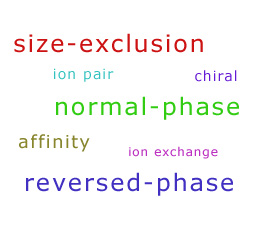 Liquid chromatography offers numerous possibilities how to separate samples of interest. By changing the composition of mobile phase and/or character of stationary phase the separation efficiency and selectivity can be completely change. Read more about main liquid chromatography modes.
Liquid chromatography offers numerous possibilities how to separate samples of interest. By changing the composition of mobile phase and/or character of stationary phase the separation efficiency and selectivity can be completely change. Read more about main liquid chromatography modes.
Size-exclusion chromatography (SEC)
Size-exclusion chromatography (also known as gel permeation chromatography, GPC) is separation technique, where no interaction of the analyzed sample and stationary phase takes place. The sample is separated only according size (related to the molar mass) and pore characteristics of the stationary phase.
Because of their size, large molecules are not able to enter small pores and are excluded from the column even before the front of the mobile phase. On the other hand, small compounds can penetrate in all small pores and elute later. Elution volume of very small compound (such as toluene) is than equal to the column hold-up volume.
In size-exclusion chromatography, usually all compounds are eluted in the elution window created by the very large sample with molar mass about 2 – 3 000 000 and very small compound such as toluene.
Applications
Size-exclusion chromatography (SEC) is usually used for separation and characterization of synthetic and natural polymer. In polymer chemistry is useful for determination of molar mass of synthesized polymers.
SEC can be used also for characterization of the porous properties of chromatographic column. Then, we are speaking about inverse size-exclusion chromatography (ISEC).
Normal phase chromatography (NP)
In one of the oldest chromatographic technique normal phase liquid chromatography (NP) the stationary phase is polar and the mobile phase non-polar. Silicagel, aluminuim oxide or polyamide are usual materials used as the stationary phases in normal phase liquid chromatography. Non-polar hydrocarbons such as hexane, heptane serves as mobile phase.
Retention is controlled by the surface area of the sorbent and polarity of the sample. More polar samples elute later (because of higher interaction with the polar stationary phase).
Reversed-phase chromatography (RP)
As the name suggests, the stationary phase – mobile phase arrangement is reversed to the normal phase chromatography. From my point of view, the normal phase chromatography names normal only because of the earlier development. Otherwise, the reversed-phase chromatography (RP) dominates in the liquid chromatography separations.
The compounds in RP are separated according the polarity – more polar elute first.
The stationary phase is non-polar. The majority of RP stationary phases is polar silica gel modified with the non-polar groups – usually alkyl chains. These alkyl chains have different length (4 – 18 carbon atoms) and functional end groups (amino, cyano, aromatic, …).
Usually, only 4 various solvents and their combinations are used in RP liquid-chromatography: acetonitrile, methanol, tetrahydrofuran and water.
Reversed-phase liquid chromatography can be used for endless different applications in pharmaceutical industry, biochemistry, polymer analysis to name a few.
Normal phase vs. reversed-phase chromatography
Are you always confused which one is which one? Usually, I had a problem to remember that in normal phase chromatography the stationary phase is polar and mobile phase non-polar, while the stationary phase is non-polar and mobile phase polar in reversed-phase chromatography.
You don’t have to remember all these differences. Only you have to remember, that -as mentioned earlier – there are only 4 solvents in reversed-phase chromatography (ACN, MeOH, THF and H2O). If you remember this you won. These solvents are polar, therefore the stationary phase has to be non-polar and therefore the chromatography uses reversed-phase. It always worked for me.
Ion exchange chromatography (IEX)
The retention in ion exchange chromatography is based on the ionic interaction between the ion on the surface of the stationary phase and oppositely charged sample ions. It can be used for both, cations (cation exchange chromatography) and anions (anion exchange chromatography).
Applications
Very common application of ion exchange chromatography is separation of proteins. These compounds have functional groups which can be positively or negatively charged. Each protein has a different charge in certain mobile phase and therefore can be separated from others. Very important characteristic of the mobile phase is its pH which controls the charges of proteins.
Affinity chromatography
Another technique very useful in separation of biological samples. In affinity chromatography the stationary phase contains functional groups with very specific reaction to the analytes. The general example can be antigen – antibody couple.
The specific reaction with the sample allows very selective separation of target compound.
Chiral separations
In chiral chromatography the compounds are separated according their chiral activity – chirality. Human hands are nice example of the chirality – same structure, mirror image.
The stationary phases in chiral chromatography have chiral selector on the surface, such as cyclodextrines, vancomycin or crown ethers.
Applications
Chiral chromatography dominates in pharmaceutical industry. Generally, only one chiral compound has any biological activity, whereas the other not. Therefore, it is very important to separate these two compound.